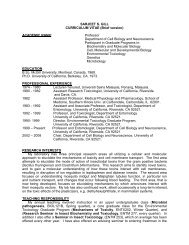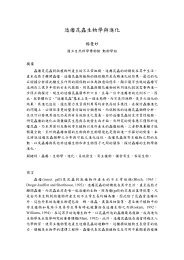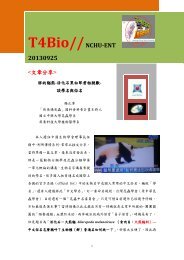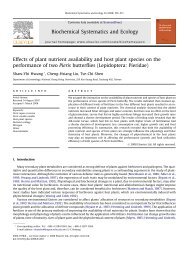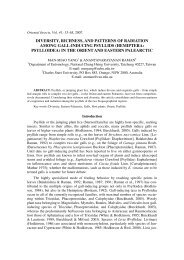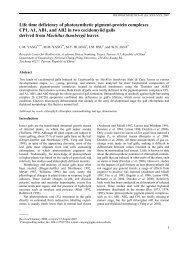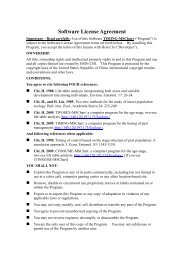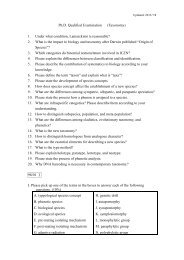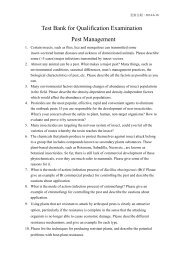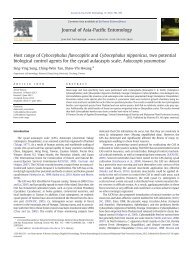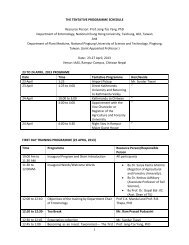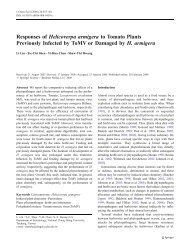Chi, H., and H. Liu. 1985. Two new methods for the study of insect ...
Chi, H., and H. Liu. 1985. Two new methods for the study of insect ...
Chi, H., and H. Liu. 1985. Two new methods for the study of insect ...
Create successful ePaper yourself
Turn your PDF publications into a flip-book with our unique Google optimized e-Paper software.
232 HSIN CHI AND HSI LIU<br />
TABLE 1<br />
The population parameters <strong>of</strong><br />
P. xylostella at 25<br />
The intrinsic rate <strong>of</strong> increase (r) 0.2229<br />
The net reproductive rate (R 0 ) 120.93<br />
The mean generation time (T) 21.51<br />
The finite rate <strong>of</strong> increase ) 1.2497<br />
e -rx l x m x=1 <strong>and</strong> (e -rx s xj f xj)=1. The<br />
same results are obtained from both <strong>for</strong>mulae.<br />
The detail data are given in Table 1.<br />
The stable age-stage-distribution <strong>of</strong> P.<br />
xylostella is calculated according to <strong>the</strong><br />
procedure <strong>of</strong> <strong>the</strong> previous section <strong>and</strong> is given<br />
in Fig. 9. In Fig. 9 <strong>the</strong> stable age distribution<br />
<strong>and</strong> stable stage distribution are also listed.<br />
(1) Basic concept<br />
THE MULTIDIMENSIONAL<br />
MATRIX MODEL<br />
Fig. 8. The distribution <strong>of</strong> mortality (Matrix<br />
P) <strong>of</strong> P. xylostella at 25. (E-egg<br />
stage, L 1 -first larval instar, L 2-4 -second<br />
to fourth larval instars, P-pupal stage,<br />
F-female, M-male). (There are round<strong>of</strong>f<br />
errors).<br />
(4) The intrinsic rate <strong>of</strong> increase <strong>and</strong> <strong>the</strong> stable<br />
age-stage-distribution <strong>of</strong> P. xylostella at<br />
25.<br />
With matrices F <strong>and</strong> S <strong>the</strong> intrinsic rate<br />
<strong>of</strong> increase are obtained by using <strong>for</strong>mulae<br />
The basic concept <strong>of</strong> <strong>the</strong> spatial distribution<br />
<strong>of</strong> host plants <strong>and</strong> <strong>the</strong> age-structure <strong>of</strong><br />
<strong>insect</strong>s on <strong>the</strong>m is displayed in Fig. 10.<br />
According to Fig. 10, if we use a three<br />
dimensional matrix N to represent this field<br />
population, <strong>the</strong>n <strong>the</strong> element n 6,3,1 gives <strong>the</strong><br />
number <strong>of</strong> individuals aged six <strong>and</strong> on <strong>the</strong><br />
host plant (or in <strong>the</strong> habitat) located at third<br />
column <strong>and</strong> first row. For example, n 6,3,1 =5<br />
denotes that <strong>the</strong>re are five individuals aged<br />
six on that host plant. Using this concept we<br />
can set <strong>the</strong> total field population into such a<br />
three dimensional matrix. Each hostplant has<br />
its own subpopulation <strong>and</strong> <strong>the</strong> spatial location<br />
is given by <strong>the</strong> subscripts.<br />
However, <strong>for</strong> those animals with metamorphosis,<br />
such as <strong>insect</strong>s <strong>and</strong> mites, <strong>the</strong><br />
inadequacy <strong>of</strong> single column matrix <strong>for</strong><br />
population structure has been discussed in<br />
previous sections. Combining this concept pf<br />
multidimensional matrix <strong>for</strong> spatial distribution<br />
<strong>and</strong> that <strong>of</strong> multiple column matrix<br />
<strong>for</strong> age-stage-structure, a four dimensional<br />
matrix is used to represent <strong>the</strong> age-stagestructure<br />
<strong>of</strong> <strong>insect</strong> population in field. Thus,



